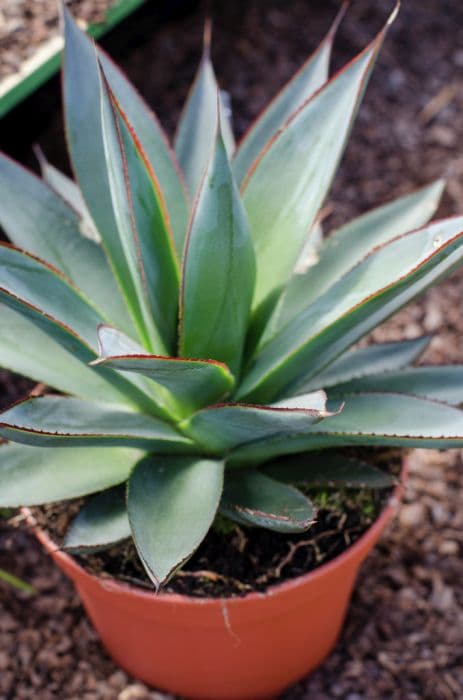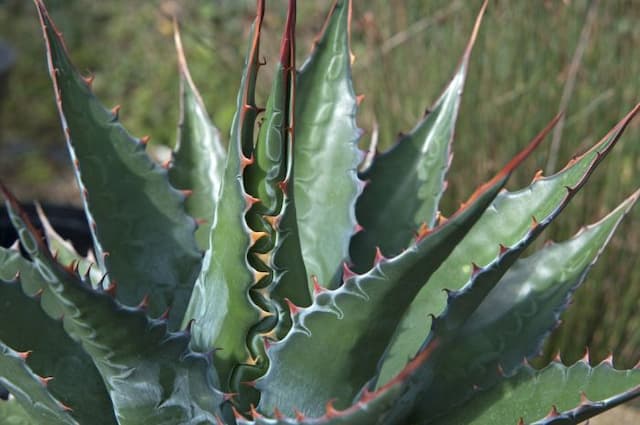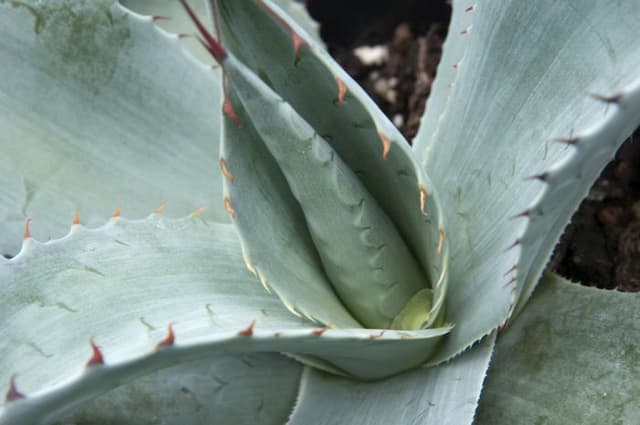Hosta Hosta 'Wolverine' (v)

ABOUT
Hosta 'Wolverine' is a visually striking perennial plant known for its distinctive foliage. The leaves are elongated with a pointed tip, presenting a narrow, oval shape with a wavy edge that adds a sense of movement and texture to the garden. The color of the leaves is particularly noteworthy—the central portion of each leaf exhibits a rich, bright blue-green hue, which is beautifully contrasted by wide, creamy yellow to white margins that frame the blue-green center attractively. As the seasons change, so does the variegation of the leaves, often becoming more pronounced and vibrant. The leaves boast a glossy finish, which catches the light and can give the plant a luminous quality, especially when dappled sunlight filters through the foliage. In the summer months, Hosta 'Wolverine' produces flower stalks that rise above the foliage, upon which delicate, bell-shaped flowers bloom. These flowers are typically a soft lavender to purple color, adding a vertical dimension and a splash of floral color to the plant's overall appearance. The arching nature of the leaves gives Hosta 'Wolverine' a relaxed yet elegant appearance, making it a popular choice for gardeners who wish to create a serene setting with visually engaging textures and colors. This hosta is often used in shade gardens, where its cool tones provide a calming background or as an accent plant to highlight its striking variegation.
About this plant
 Names
NamesFamily
Asparagaceae
Synonyms
Plantain Lily, Funkia, Hosta
Common names
Hosta 'Wolverine'
 Toxicity
ToxicityTo humans
Hostas, including the Hosta 'Wolverine' variety, are generally not toxic to humans. If ingested in large quantities, they might cause mild stomach upset, but they are not known to contain any significant toxins that would cause serious harm or poisoning to people. Therefore, symptoms of poisoning are not typically a concern with the ingestion of Hosta plants for humans.
To pets
Hostas, generally referred to by their common name 'plantain lilies', can be toxic to pets, especially dogs and cats. If a pet ingests part of a Hosta plant, they could experience symptoms such as vomiting, diarrhea, and loss of appetite. More severe reactions could include depression of the central nervous system. If you suspect your pet has ingested a Hosta plant, it's important to contact your veterinarian.
 Characteristics
CharacteristicsLife cycle
Perennials
Foliage type
Deciduous
Color of leaves
Variegated
Flower color
Lavender
Height
1 foot 20 inches (50 cm)
Spread
2 feet 60 inches (60 cm)
Plant type
Herb
Hardiness zones
3
Native area
Asia
Benefits
 General Benefits
General Benefits- Easy to grow: Hosta 'Wolverine' is known for its hardiness and ease of culture, making it a great choice for both novice and experienced gardeners.
- Shade tolerance: It thrives in shady areas where other plants might struggle, making it ideal for woodland gardens or under trees.
- Attractive foliage: This variety has striking blue-green leaves with wavy margins, adding texture and color to the garden throughout the growing season.
- Low maintenance: Hosta 'Wolverine' requires minimal care once established, needing only occasional watering and the removal of any dead foliage.
- Sluggish pests resistant: It is known for its resistance to common garden pests such as slugs, reducing the need for chemical treatments.
- Long-lived perennial: Hosta 'Wolverine' can live for many years, providing a long-term presence in the garden and requiring less frequent replacement than annuals.
- Drought tolerance: Once established, it is fairly drought-tolerant, making it a good selection for gardens with less frequent rainfall.
- Visual interest: The plant's variegated leaves add a unique visual contrast amongst other garden plants, especially in shaded areas.
- Suitable for containers: It can be successfully grown in containers, allowing for flexibility in garden design and suitability for small spaces like patios or balconies.
- Seasonal blooms: Hosta 'Wolverine' produces delicate flowers that can attract butterflies and bees, adding to the biodiversity of the garden.
 Medical Properties
Medical PropertiesThis plant is not used for medical purposes.
 Air-purifying Qualities
Air-purifying QualitiesThis plant is not specifically known for air purifying qualities.
 Other Uses
Other Uses- Leaf Mulch: Dried leaves of Hosta 'Wolverine' can be used as a source of mulch to enrich soil and suppress weeds around garden plants.
- Compost Ingredient: The foliage can be added to compost piles to break down and contribute to the creation of rich, organic compost.
- Culinary Garnish: Hosta flowers are edible and can be used fresh as a delicate garnish for salads and cold dishes.
- Natural Dye: The leaves can be boiled to produce a natural green dye for fabrics or paper crafts.
- Photography Subject: With its striking foliage, Hosta 'Wolverine' can be a beautiful subject for botanical and garden photography.
- Artistic Inspiration: Artists may use the plant as inspiration for drawings, paintings, and other artistic endeavors.
- Erosion Control: Its dense foliage and root structure can help to stabilize soil on slopes, preventing erosion.
- Biodegradable Pots: Large Hosta leaves can be crafted into temporary biodegradable containers for seedlings that can be planted directly into the ground.
- Education: Hostas can provide an opportunity for teaching about plant growth, propagation, and care in educational settings.
- Theme Gardens: They can be incorporated into theme gardens, like shade or foliage gardens, to demonstrate design principles using leaf texture and color.
Interesting Facts
 Feng Shui
Feng ShuiThe Hosta is not used in Feng Shui practice.
 Zodiac Sign Compitability
Zodiac Sign CompitabilityThe Hosta is not used in astrology practice.
 Plant Symbolism
Plant Symbolism- Resilience: Hostas can thrive in shade, symbolizing the ability to grow and flourish even in less than ideal conditions.
- Adaptability: Given their tolerance to different environments, Hostas represent the trait of adaptability and flexibility in life.
- Devotion: The reliability of Hostas to return each year can be seen as a symbol of loyalty and steadfastness, akin to devoted love.
- Heartiness: With their robust nature, Hostas stand for physical and emotional strength.
- Longevity: As perennials, Hostas signify enduring life and longevity in various cultures.
 Water
WaterHostas, including 'Wolverine', should be watered deeply and thoroughly to encourage root development, up to one inch of water per week, considering rainfall. In the absence of rain, provide 0.62 gallons (which is equivalent to one inch of water) per square foot every week. In the warm summer months, they may require additional water to maintain moist soil. During periods of drought, water them twice a week. Reduce watering as the plant goes dormant in the fall, and avoid overwatering to prevent root rot.
 Light
LightHostas like 'Wolverine' thrive best in dappled shade or morning sun followed by afternoon shade. The ideal spot for these plants would be under the canopy of open-branched trees or on the north side of buildings where they receive adequate light without the harsh intensity of full afternoon sun.
 Temperature
Temperature'Wolverine' Hostas prefer moderate temperatures and are hardy in zones 3 through 9. They can tolerate minimum temperatures as low as -40 degrees Fahrenheit and maximum summer temperatures of around 95 degrees Fahrenheit. The ideal temperature range for growing Hostas is between 50 and 75 degrees Fahrenheit.
 Pruning
PruningHostas like 'Wolverine' require minimal pruning, which is primarily to remove dead or damaged leaves and to deadhead flower stalks after blooming. Pruning can be done any time during the growing season as needed. The best time for a general tidy-up is early spring before the leaves unfurl or immediately after the first frost when the plant enters dormancy.
 Cleaning
CleaningAs needed
 Soil
SoilThe best soil mix for Hosta 'Wolverine' is a well-draining mix with organic matter, such as a blend of loamy soil, peat, and perlite. The pH should be slightly acidic to neutral, ranging from 6.0 to 7.0 for optimal growth.
 Repotting
RepottingHostas generally do not require frequent repotting and can thrive for several years in the same pot. Repot Hosta 'Wolverine' every 3 to 5 years, or when the plant outgrows its current container.
 Humidity & Misting
Humidity & MistingHosta 'Wolverine' prefers moderate humidity levels but is tolerant of a range of conditions. Aim for a humidity level between 40% to 70% for this variety to thrive.
 Suitable locations
Suitable locationsIndoor
Place in indirect light, keep soil moist, and ensure good air circulation.
Outdoor
Plant in partial shade, provide mulch, and shield from strong winds.
Hardiness zone
3-9 USDA
 Life cycle
Life cycleHosta 'Wolverine', also known simply as Hosta, is a perennial plant that begins its life cycle with germination from seed, although commercially it is more commonly propagated by division. Once established, the plant emerges from dormancy in early spring with the sprouting of pointed, lance-shaped leaves that gradually unfurl. As the weather warms, the Hosta grows into a clump of overlapping leaves that can be quite expansive depending on the variety. By mid-summer, it produces tall, leafless stalks called scapes which bear bell-shaped or funnel-shaped flowers ranging from white to lavender in color. After flowering, the seeds develop and, if not deadheaded, can fall to the ground to potentially germinate and create new plants. With the onset of autumn and cooler temperatures, the Hosta's foliage dies back, and the plant enters into a state of dormancy over the winter, ready to restart the cycle come spring.
 Propogation
PropogationPropogation time
Spring to Summer
The Hosta 'Wolverine', commonly known as just Hosta, is often propagated in early spring or late summer by division, the most popular method for multiplying these plants. To propagate by division, dig up the entire Hosta plant as the new growth begins to emerge. Carefully separate the plant into smaller sections, ensuring that each division has at least one growing point or "eye" and several roots. Replant these divisions immediately into a well-prepared site with ample space for the roots to spread out. Water the newly planted divisions thoroughly, providing an inch (2.5 cm) of water per week if rainfall is insufficient. This straightforward method allows gardeners to quickly expand their Hosta collection and rejuvenate older, overcrowded plants.









